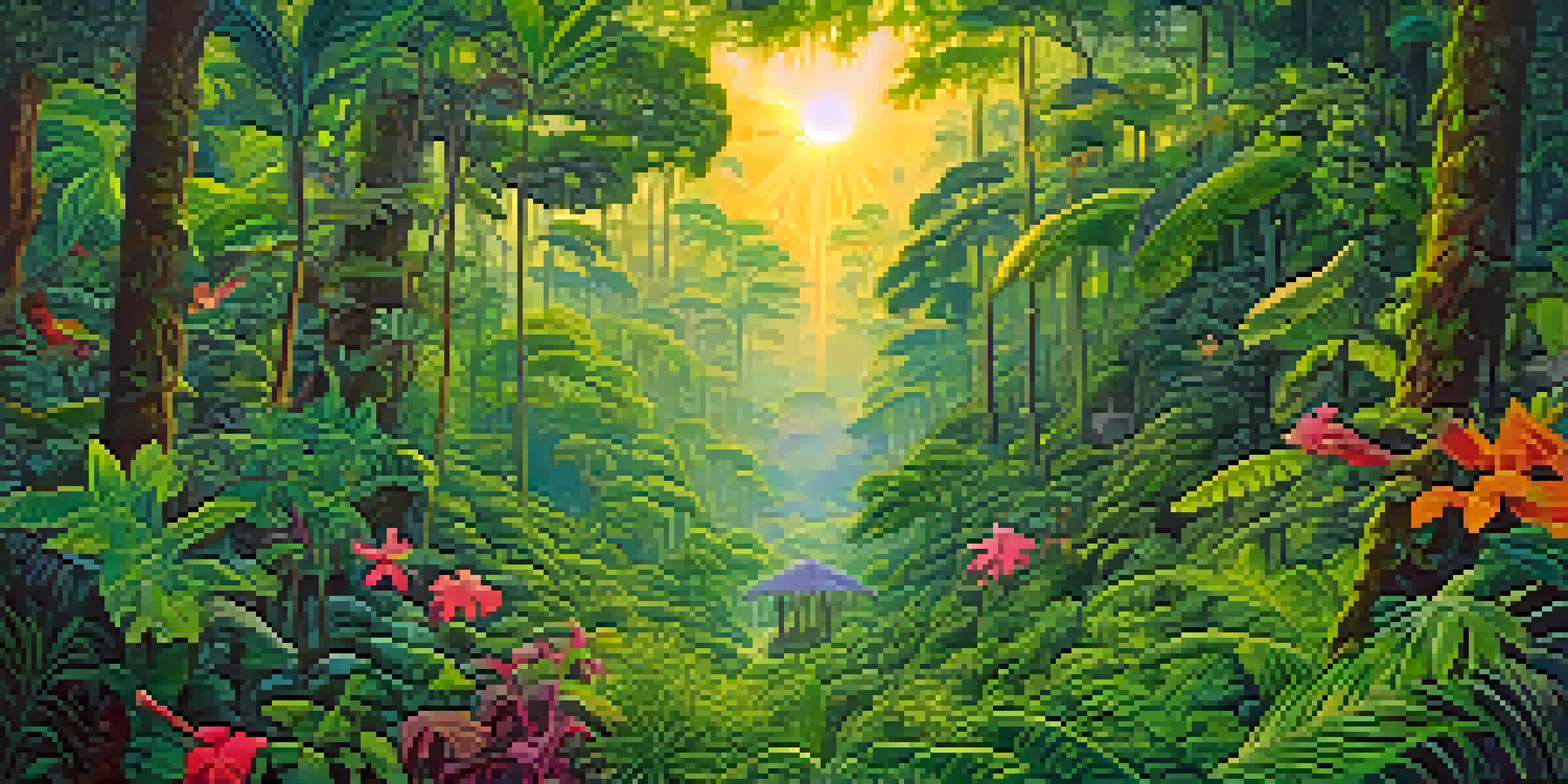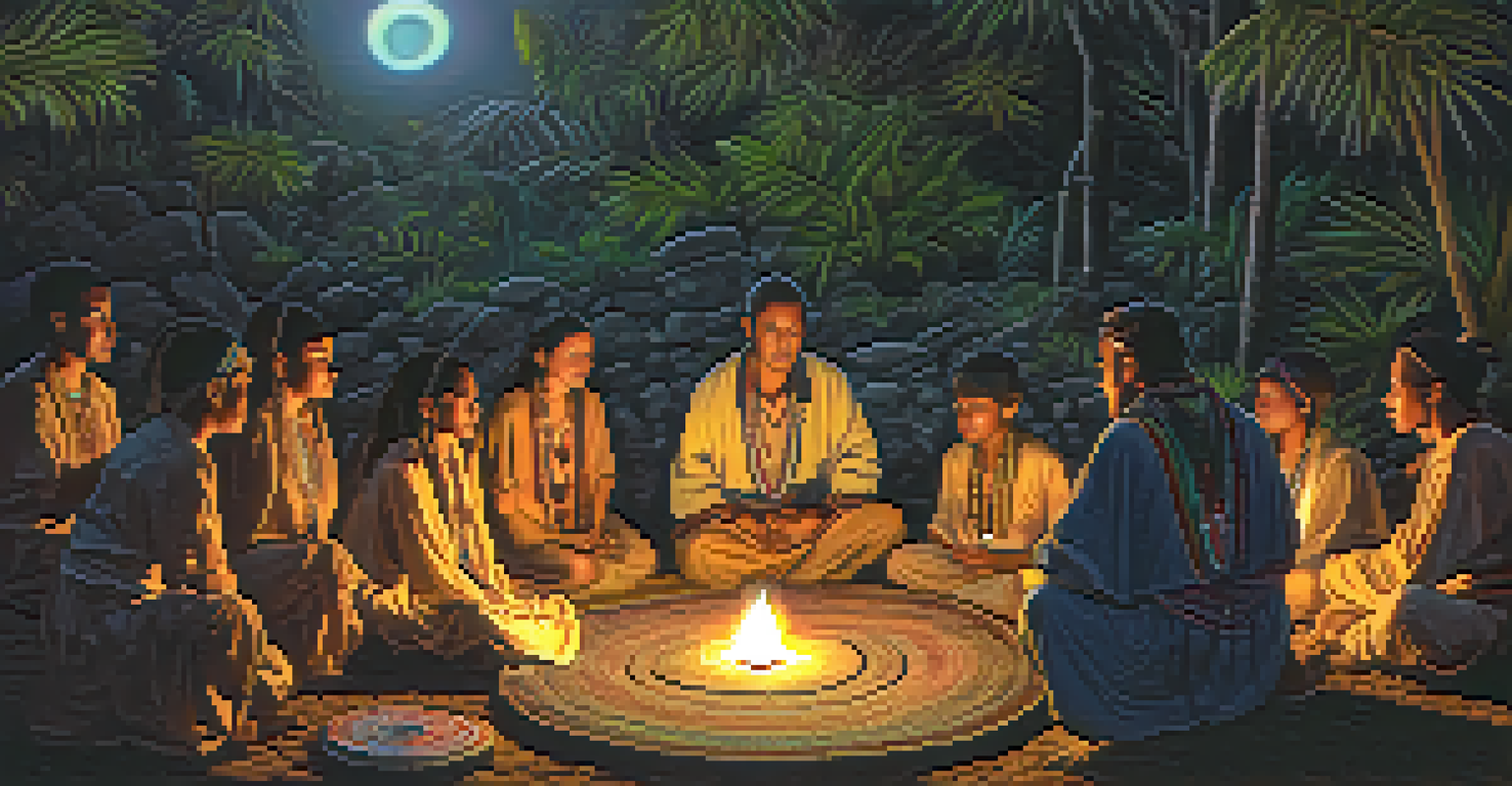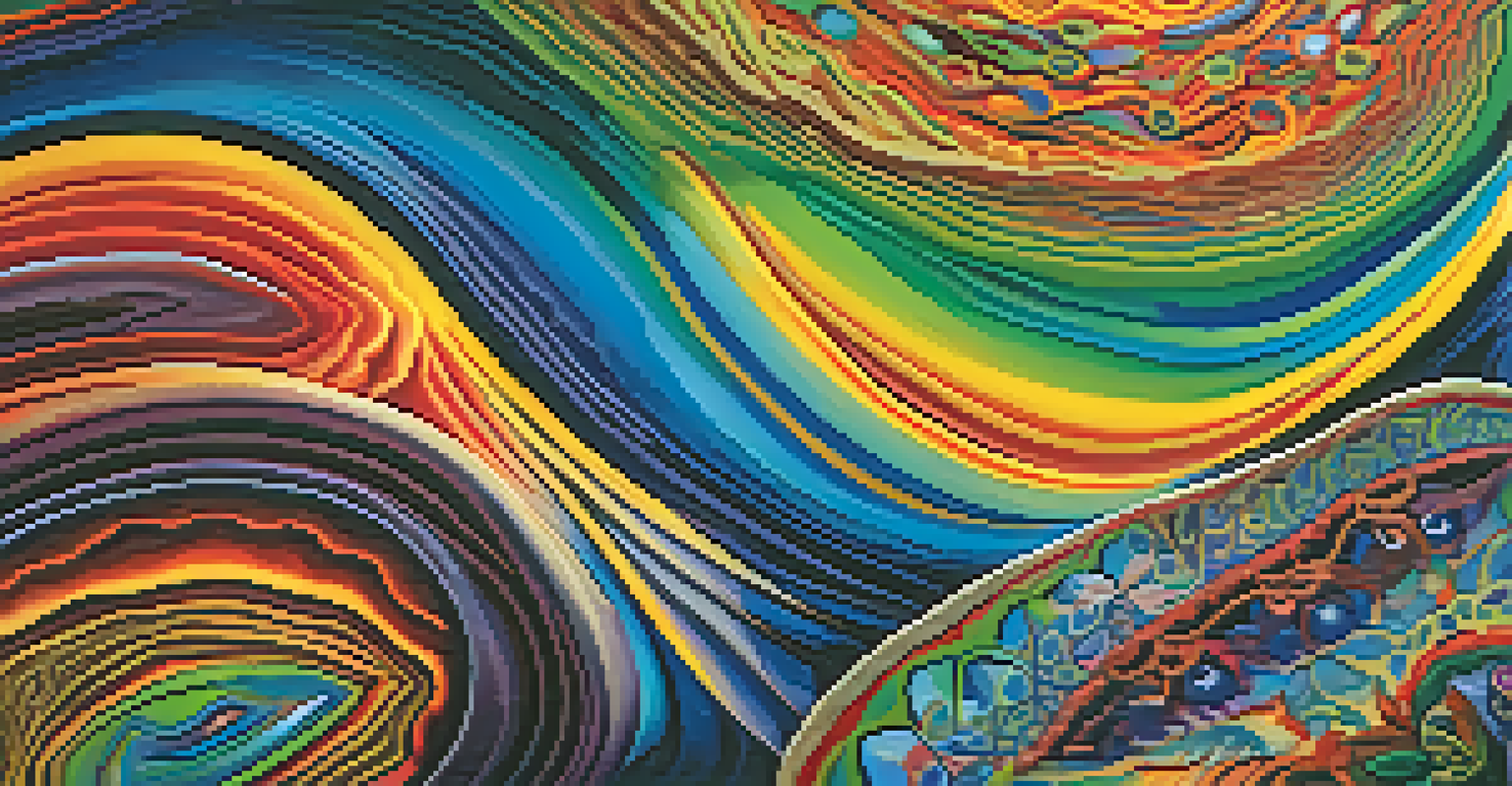The Visual Arts: Ayahuasca's Influence on Contemporary Artists

Understanding Ayahuasca and Its Cultural Significance
Ayahuasca, a traditional Amazonian brew, has long been used for spiritual and healing purposes. It combines two plants: the Banisteriopsis caapi vine and the leaves of the Psychotria viridis shrub, creating a powerful psychoactive experience. For centuries, indigenous cultures have relied on Ayahuasca to foster connections with the spiritual realm and gain insights into their lives.
Ayahuasca is not a drug; it is a tradition. It is a portal to deeper understanding and connection with oneself and the universe.
In recent years, Ayahuasca has gained popularity beyond its native context, attracting individuals seeking deeper meaning and self-discovery. This surge in interest has sparked a fascinating dialogue between ancient practices and contemporary artistic expression. Artists are increasingly turning to Ayahuasca as a source of inspiration, exploring its potential to unlock creativity and provoke thought.
Understanding this brew's cultural significance is key to appreciating its influence on modern artists. By examining the rituals and beliefs surrounding Ayahuasca, we can see how its transformative effects resonate with contemporary themes of identity, spirituality, and interconnectedness.
The Journey: Ayahuasca Experiences in Artistic Creation
Many contemporary artists have participated in Ayahuasca ceremonies, claiming the experience opens new channels of creativity. During these journeys, participants often report vivid visions, emotional releases, and profound insights that inspire their art. This heightened state of awareness can lead to unique interpretations of reality that challenge conventional artistic norms.

For instance, artists like Alex Grey and Pablo Amaringo have vividly depicted their Ayahuasca experiences through intricate paintings. Their works often feature psychedelic imagery and spiritual symbolism, inviting viewers to explore realms beyond the ordinary. This blend of personal experience and artistic expression creates a bridge between the inner self and the outer world.
Ayahuasca's Cultural Impact on Art
Ayahuasca has inspired contemporary artists to explore themes of spirituality and identity through their work.
Such journeys can be both enlightening and daunting, offering a raw glimpse into the human psyche. As artists navigate these experiences, their work becomes a reflection of their spiritual exploration, encouraging audiences to engage with their own perceptions of reality.
Ayahuasca's Role in Shaping Visual Aesthetics
The vibrant colors and intricate patterns often associated with Ayahuasca experiences are beginning to influence the aesthetics of contemporary art. Artists are experimenting with bold hues and fluid forms that mimic the visual phenomena reported during Ayahuasca journeys. This shift not only alters how art is created but also how it is perceived by audiences.
Art is the most beautiful of all lies; it can make us feel and explore the depths of our psyche, just like an Ayahuasca journey.
Art movements like psychedelic art and visionary art draw heavily from the Ayahuasca experience, showcasing a blend of spiritual and psychological themes. For example, the bright, swirling colors in these artworks evoke the mind-altering sensations of Ayahuasca, making the viewer feel as if they are part of the journey. This connection between art and altered states of consciousness fosters a deeper appreciation for the creative process.
As artists continue to explore these visual aesthetics, they invite viewers to step outside their comfort zones and embrace new ways of seeing. This evolving aesthetic language speaks to the universality of human experience, bridging cultural divides and encouraging a shared exploration of consciousness.
Collaborations Between Artists and Shamans
In an intriguing fusion of ancient wisdom and modern creativity, collaborations between artists and shamans are becoming more common. These partnerships often involve artists participating in traditional Ayahuasca rituals, guided by shamans who hold extensive knowledge of the brew's spiritual significance. This collaboration creates a unique space for artistic exploration rooted in tradition.
Such collaborations allow artists to delve deeper into their creative processes, often resulting in works that are rich in cultural context and spiritual insight. Artists may create pieces that reflect their experiences during the ceremonies, often incorporating elements of the shamanic tradition into their work. This blend of perspectives enriches the artistic dialogue and broadens the scope of contemporary art.
Healing Through Artistic Expression
Many artists utilize art as a therapeutic outlet after Ayahuasca ceremonies, transforming their emotional experiences into creative expression.
Through these partnerships, both artists and shamans benefit, creating a reciprocal relationship that honors the past while paving the way for future expressions. This collaboration highlights the importance of cultural respect and understanding, positioning artists as conduits of ancient wisdom in the modern world.
Ayahuasca and the Exploration of Identity
Ayahuasca's impact on identity exploration is profound, particularly in the works of contemporary artists. Many individuals report that their journeys lead to a deeper understanding of themselves and their place in the world. This personal metamorphosis often translates into art that challenges societal norms and invites viewers to rethink their own identities.
For example, artists like Erin Yoshi and Amanda Sage incorporate themes of self-discovery and transformation in their work, often using Ayahuasca experiences as a backdrop. Their art serves as a mirror, reflecting the complexities of identity in today's world while celebrating the beauty of individual journeys. This exploration of self resonates with many, encouraging a sense of connection and shared experience.
As artists navigate their identity through the lens of Ayahuasca, they create a space where viewers can also explore their identities. This dialogue fosters empathy and understanding, illustrating how personal experiences can transcend individual boundaries and connect us all.
Healing Through Art: The Therapeutic Aspect of Ayahuasca
The therapeutic potential of Ayahuasca extends beyond individual experiences; it also encompasses the realm of artistic expression. Many artists find that creating art after an Ayahuasca ceremony serves as a form of healing, allowing them to process their emotions and experiences. This connection between art and healing has become a significant theme in contemporary visual arts.
Art can be a powerful tool for expressing complex feelings that might be difficult to articulate otherwise. Through painting, sculpting, or other mediums, artists can channel their experiences into tangible forms, transforming pain into beauty. This therapeutic process not only benefits the artist but also resonates with audiences, creating a shared emotional experience.
Future of Ayahuasca in Artistic Trends
The influence of Ayahuasca on visual arts is expected to evolve, blending traditional practices with modern techniques to inspire new forms of expression.
In this way, Ayahuasca acts as a catalyst for healing, enabling artists to confront their inner struggles and use their creative talents to find peace. The resulting artwork often carries a message of hope and resilience, inviting viewers to engage with their own healing journeys.
Future Trends: The Ongoing Influence of Ayahuasca in Art
As the appreciation for Ayahuasca and its effects continues to grow, its influence on visual arts is expected to evolve further. Artists are likely to delve deeper into the themes of consciousness, spirituality, and identity, using Ayahuasca as a springboard for exploration. This ongoing relationship between art and Ayahuasca highlights the importance of cultural exchange and collaboration.
Emerging artists are increasingly integrating traditional practices with modern techniques, creating a rich tapestry of artistic expression. This fusion not only preserves the cultural significance of Ayahuasca but also allows for innovative interpretations that resonate with contemporary audiences. The art world is becoming a vibrant space for dialogue, where ancient wisdom meets modern creativity.

Looking ahead, we can anticipate an exciting future where Ayahuasca's influence on visual arts continues to inspire and challenge artists and viewers alike. This journey of exploration and expression invites everyone to engage with the profound connections between art, spirituality, and the human experience.